sukuk bond financial market and GCC nations
VerifiedAdded on 2022/07/21
|9
|2693
|37
AI Summary
This research is unique because it explains the significance of sukuk bonds in the financial markets over the last 10 years. During the period 2011-2020, the research looked at the evolution of sukuk issuance in six GCC nations (Bahrain, Kuwait, Oman, Qatar, Saudi Arabia, and the United Arab Emirates).
Contribute Materials
Your contribution can guide someone’s learning journey. Share your
documents today.
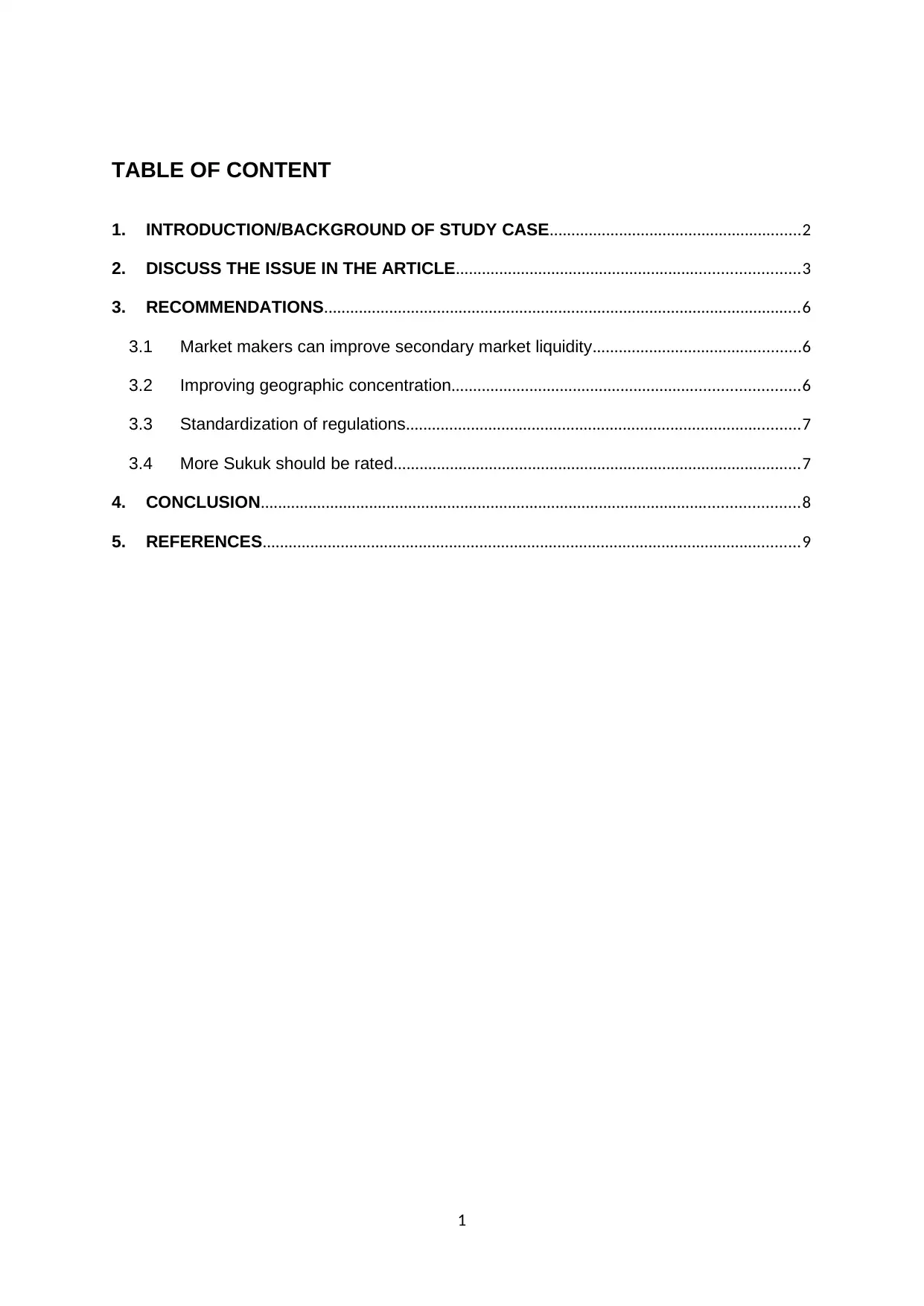
TABLE OF CONTENT
1. INTRODUCTION/BACKGROUND OF STUDY CASE..........................................................2
2. DISCUSS THE ISSUE IN THE ARTICLE...............................................................................3
3. RECOMMENDATIONS..............................................................................................................6
3.1 Market makers can improve secondary market liquidity................................................6
3.2 Improving geographic concentration................................................................................6
3.3 Standardization of regulations...........................................................................................7
3.4 More Sukuk should be rated..............................................................................................7
4. CONCLUSION............................................................................................................................8
5. REFERENCES............................................................................................................................9
1
1. INTRODUCTION/BACKGROUND OF STUDY CASE..........................................................2
2. DISCUSS THE ISSUE IN THE ARTICLE...............................................................................3
3. RECOMMENDATIONS..............................................................................................................6
3.1 Market makers can improve secondary market liquidity................................................6
3.2 Improving geographic concentration................................................................................6
3.3 Standardization of regulations...........................................................................................7
3.4 More Sukuk should be rated..............................................................................................7
4. CONCLUSION............................................................................................................................8
5. REFERENCES............................................................................................................................9
1
Secure Best Marks with AI Grader
Need help grading? Try our AI Grader for instant feedback on your assignments.
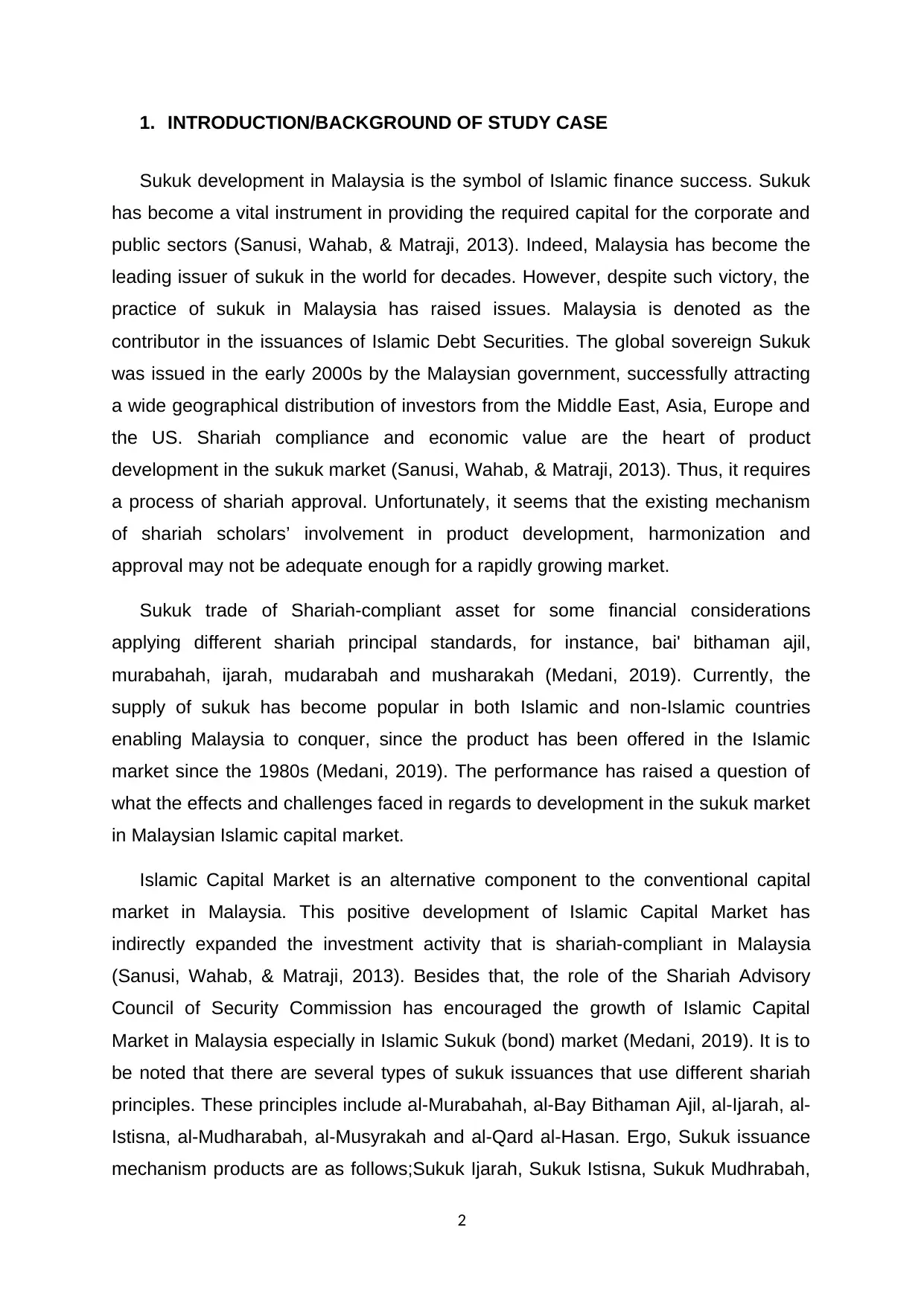
1. INTRODUCTION/BACKGROUND OF STUDY CASE
Sukuk development in Malaysia is the symbol of Islamic finance success. Sukuk
has become a vital instrument in providing the required capital for the corporate and
public sectors (Sanusi, Wahab, & Matraji, 2013). Indeed, Malaysia has become the
leading issuer of sukuk in the world for decades. However, despite such victory, the
practice of sukuk in Malaysia has raised issues. Malaysia is denoted as the
contributor in the issuances of Islamic Debt Securities. The global sovereign Sukuk
was issued in the early 2000s by the Malaysian government, successfully attracting
a wide geographical distribution of investors from the Middle East, Asia, Europe and
the US. Shariah compliance and economic value are the heart of product
development in the sukuk market (Sanusi, Wahab, & Matraji, 2013). Thus, it requires
a process of shariah approval. Unfortunately, it seems that the existing mechanism
of shariah scholars’ involvement in product development, harmonization and
approval may not be adequate enough for a rapidly growing market.
Sukuk trade of Shariah-compliant asset for some financial considerations
applying different shariah principal standards, for instance, bai' bithaman ajil,
murabahah, ijarah, mudarabah and musharakah (Medani, 2019). Currently, the
supply of sukuk has become popular in both Islamic and non-Islamic countries
enabling Malaysia to conquer, since the product has been offered in the Islamic
market since the 1980s (Medani, 2019). The performance has raised a question of
what the effects and challenges faced in regards to development in the sukuk market
in Malaysian Islamic capital market.
Islamic Capital Market is an alternative component to the conventional capital
market in Malaysia. This positive development of Islamic Capital Market has
indirectly expanded the investment activity that is shariah-compliant in Malaysia
(Sanusi, Wahab, & Matraji, 2013). Besides that, the role of the Shariah Advisory
Council of Security Commission has encouraged the growth of Islamic Capital
Market in Malaysia especially in Islamic Sukuk (bond) market (Medani, 2019). It is to
be noted that there are several types of sukuk issuances that use different shariah
principles. These principles include al-Murabahah, al-Bay Bithaman Ajil, al-Ijarah, al-
Istisna, al-Mudharabah, al-Musyrakah and al-Qard al-Hasan. Ergo, Sukuk issuance
mechanism products are as follows;Sukuk Ijarah, Sukuk Istisna, Sukuk Mudhrabah,
2
Sukuk development in Malaysia is the symbol of Islamic finance success. Sukuk
has become a vital instrument in providing the required capital for the corporate and
public sectors (Sanusi, Wahab, & Matraji, 2013). Indeed, Malaysia has become the
leading issuer of sukuk in the world for decades. However, despite such victory, the
practice of sukuk in Malaysia has raised issues. Malaysia is denoted as the
contributor in the issuances of Islamic Debt Securities. The global sovereign Sukuk
was issued in the early 2000s by the Malaysian government, successfully attracting
a wide geographical distribution of investors from the Middle East, Asia, Europe and
the US. Shariah compliance and economic value are the heart of product
development in the sukuk market (Sanusi, Wahab, & Matraji, 2013). Thus, it requires
a process of shariah approval. Unfortunately, it seems that the existing mechanism
of shariah scholars’ involvement in product development, harmonization and
approval may not be adequate enough for a rapidly growing market.
Sukuk trade of Shariah-compliant asset for some financial considerations
applying different shariah principal standards, for instance, bai' bithaman ajil,
murabahah, ijarah, mudarabah and musharakah (Medani, 2019). Currently, the
supply of sukuk has become popular in both Islamic and non-Islamic countries
enabling Malaysia to conquer, since the product has been offered in the Islamic
market since the 1980s (Medani, 2019). The performance has raised a question of
what the effects and challenges faced in regards to development in the sukuk market
in Malaysian Islamic capital market.
Islamic Capital Market is an alternative component to the conventional capital
market in Malaysia. This positive development of Islamic Capital Market has
indirectly expanded the investment activity that is shariah-compliant in Malaysia
(Sanusi, Wahab, & Matraji, 2013). Besides that, the role of the Shariah Advisory
Council of Security Commission has encouraged the growth of Islamic Capital
Market in Malaysia especially in Islamic Sukuk (bond) market (Medani, 2019). It is to
be noted that there are several types of sukuk issuances that use different shariah
principles. These principles include al-Murabahah, al-Bay Bithaman Ajil, al-Ijarah, al-
Istisna, al-Mudharabah, al-Musyrakah and al-Qard al-Hasan. Ergo, Sukuk issuance
mechanism products are as follows;Sukuk Ijarah, Sukuk Istisna, Sukuk Mudhrabah,
2
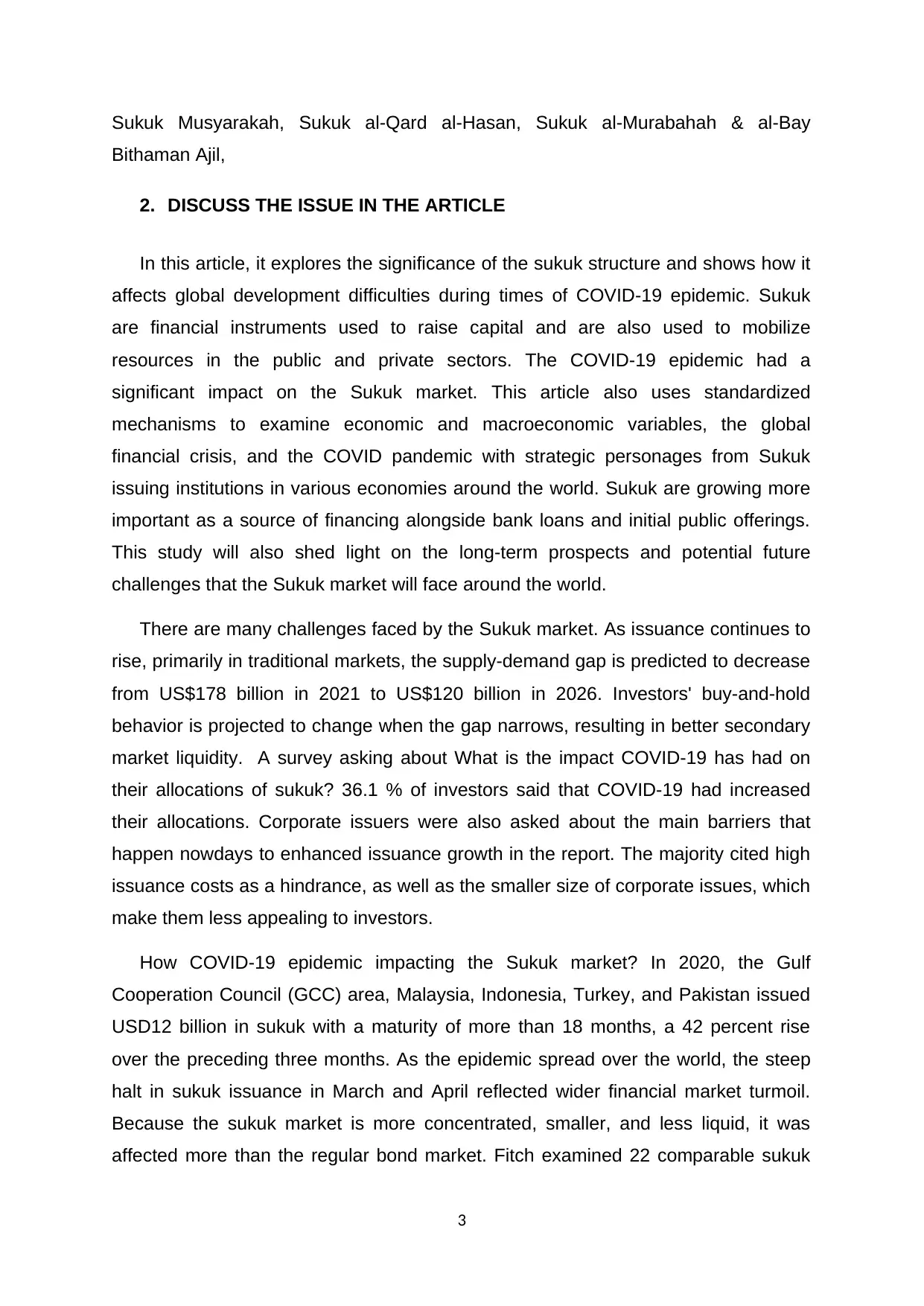
Sukuk Musyarakah, Sukuk al-Qard al-Hasan, Sukuk al-Murabahah & al-Bay
Bithaman Ajil,
2. DISCUSS THE ISSUE IN THE ARTICLE
In this article, it explores the significance of the sukuk structure and shows how it
affects global development difficulties during times of COVID-19 epidemic. Sukuk
are financial instruments used to raise capital and are also used to mobilize
resources in the public and private sectors. The COVID-19 epidemic had a
significant impact on the Sukuk market. This article also uses standardized
mechanisms to examine economic and macroeconomic variables, the global
financial crisis, and the COVID pandemic with strategic personages from Sukuk
issuing institutions in various economies around the world. Sukuk are growing more
important as a source of financing alongside bank loans and initial public offerings.
This study will also shed light on the long-term prospects and potential future
challenges that the Sukuk market will face around the world.
There are many challenges faced by the Sukuk market. As issuance continues to
rise, primarily in traditional markets, the supply-demand gap is predicted to decrease
from US$178 billion in 2021 to US$120 billion in 2026. Investors' buy-and-hold
behavior is projected to change when the gap narrows, resulting in better secondary
market liquidity. A survey asking about What is the impact COVID-19 has had on
their allocations of sukuk? 36.1 % of investors said that COVID-19 had increased
their allocations. Corporate issuers were also asked about the main barriers that
happen nowdays to enhanced issuance growth in the report. The majority cited high
issuance costs as a hindrance, as well as the smaller size of corporate issues, which
make them less appealing to investors.
How COVID-19 epidemic impacting the Sukuk market? In 2020, the Gulf
Cooperation Council (GCC) area, Malaysia, Indonesia, Turkey, and Pakistan issued
USD12 billion in sukuk with a maturity of more than 18 months, a 42 percent rise
over the preceding three months. As the epidemic spread over the world, the steep
halt in sukuk issuance in March and April reflected wider financial market turmoil.
Because the sukuk market is more concentrated, smaller, and less liquid, it was
affected more than the regular bond market. Fitch examined 22 comparable sukuk
3
Bithaman Ajil,
2. DISCUSS THE ISSUE IN THE ARTICLE
In this article, it explores the significance of the sukuk structure and shows how it
affects global development difficulties during times of COVID-19 epidemic. Sukuk
are financial instruments used to raise capital and are also used to mobilize
resources in the public and private sectors. The COVID-19 epidemic had a
significant impact on the Sukuk market. This article also uses standardized
mechanisms to examine economic and macroeconomic variables, the global
financial crisis, and the COVID pandemic with strategic personages from Sukuk
issuing institutions in various economies around the world. Sukuk are growing more
important as a source of financing alongside bank loans and initial public offerings.
This study will also shed light on the long-term prospects and potential future
challenges that the Sukuk market will face around the world.
There are many challenges faced by the Sukuk market. As issuance continues to
rise, primarily in traditional markets, the supply-demand gap is predicted to decrease
from US$178 billion in 2021 to US$120 billion in 2026. Investors' buy-and-hold
behavior is projected to change when the gap narrows, resulting in better secondary
market liquidity. A survey asking about What is the impact COVID-19 has had on
their allocations of sukuk? 36.1 % of investors said that COVID-19 had increased
their allocations. Corporate issuers were also asked about the main barriers that
happen nowdays to enhanced issuance growth in the report. The majority cited high
issuance costs as a hindrance, as well as the smaller size of corporate issues, which
make them less appealing to investors.
How COVID-19 epidemic impacting the Sukuk market? In 2020, the Gulf
Cooperation Council (GCC) area, Malaysia, Indonesia, Turkey, and Pakistan issued
USD12 billion in sukuk with a maturity of more than 18 months, a 42 percent rise
over the preceding three months. As the epidemic spread over the world, the steep
halt in sukuk issuance in March and April reflected wider financial market turmoil.
Because the sukuk market is more concentrated, smaller, and less liquid, it was
affected more than the regular bond market. Fitch examined 22 comparable sukuk
3
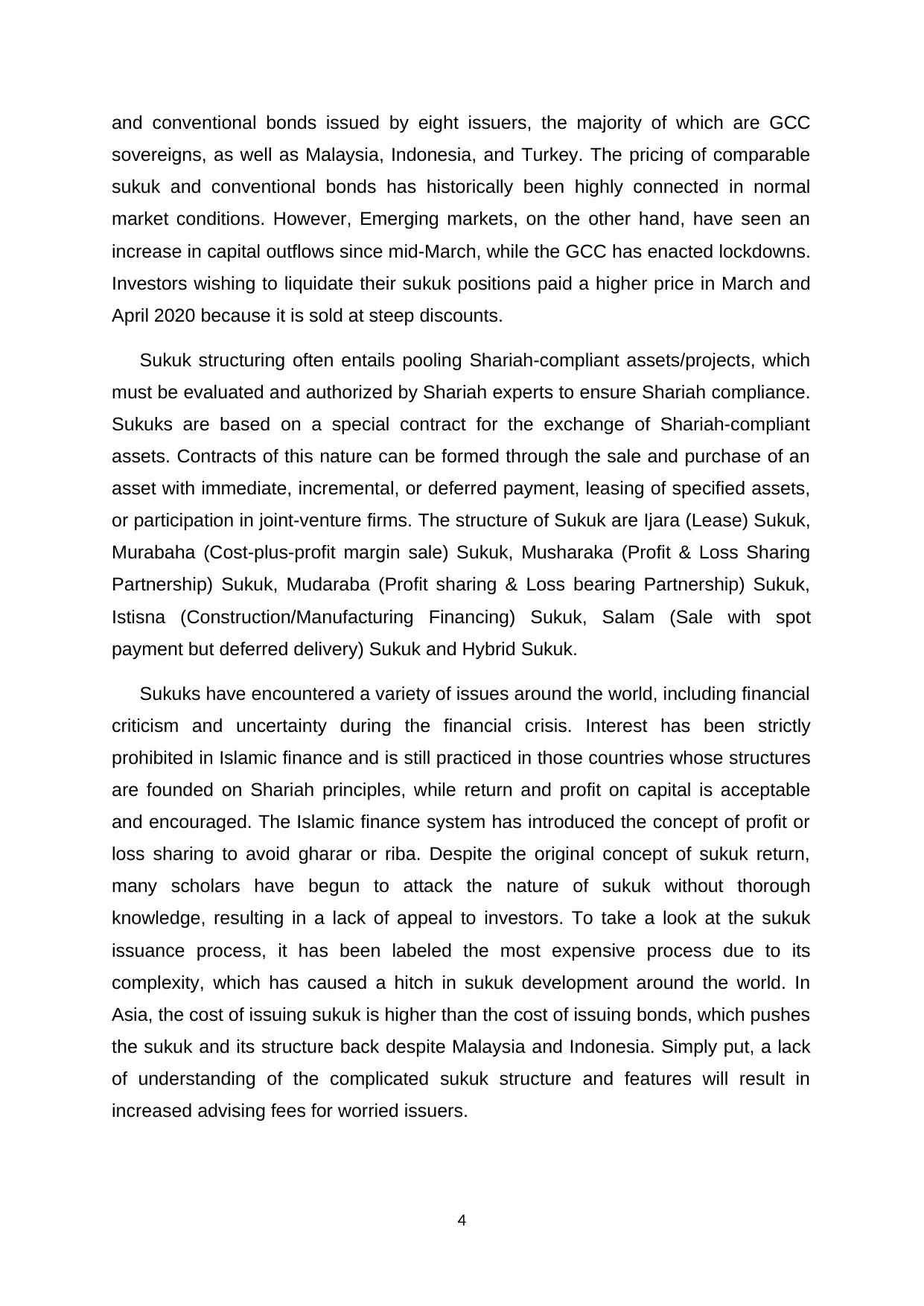
and conventional bonds issued by eight issuers, the majority of which are GCC
sovereigns, as well as Malaysia, Indonesia, and Turkey. The pricing of comparable
sukuk and conventional bonds has historically been highly connected in normal
market conditions. However, Emerging markets, on the other hand, have seen an
increase in capital outflows since mid-March, while the GCC has enacted lockdowns.
Investors wishing to liquidate their sukuk positions paid a higher price in March and
April 2020 because it is sold at steep discounts.
Sukuk structuring often entails pooling Shariah-compliant assets/projects, which
must be evaluated and authorized by Shariah experts to ensure Shariah compliance.
Sukuks are based on a special contract for the exchange of Shariah-compliant
assets. Contracts of this nature can be formed through the sale and purchase of an
asset with immediate, incremental, or deferred payment, leasing of specified assets,
or participation in joint-venture firms. The structure of Sukuk are Ijara (Lease) Sukuk,
Murabaha (Cost-plus-profit margin sale) Sukuk, Musharaka (Profit & Loss Sharing
Partnership) Sukuk, Mudaraba (Profit sharing & Loss bearing Partnership) Sukuk,
Istisna (Construction/Manufacturing Financing) Sukuk, Salam (Sale with spot
payment but deferred delivery) Sukuk and Hybrid Sukuk.
Sukuks have encountered a variety of issues around the world, including financial
criticism and uncertainty during the financial crisis. Interest has been strictly
prohibited in Islamic finance and is still practiced in those countries whose structures
are founded on Shariah principles, while return and profit on capital is acceptable
and encouraged. The Islamic finance system has introduced the concept of profit or
loss sharing to avoid gharar or riba. Despite the original concept of sukuk return,
many scholars have begun to attack the nature of sukuk without thorough
knowledge, resulting in a lack of appeal to investors. To take a look at the sukuk
issuance process, it has been labeled the most expensive process due to its
complexity, which has caused a hitch in sukuk development around the world. In
Asia, the cost of issuing sukuk is higher than the cost of issuing bonds, which pushes
the sukuk and its structure back despite Malaysia and Indonesia. Simply put, a lack
of understanding of the complicated sukuk structure and features will result in
increased advising fees for worried issuers.
4
sovereigns, as well as Malaysia, Indonesia, and Turkey. The pricing of comparable
sukuk and conventional bonds has historically been highly connected in normal
market conditions. However, Emerging markets, on the other hand, have seen an
increase in capital outflows since mid-March, while the GCC has enacted lockdowns.
Investors wishing to liquidate their sukuk positions paid a higher price in March and
April 2020 because it is sold at steep discounts.
Sukuk structuring often entails pooling Shariah-compliant assets/projects, which
must be evaluated and authorized by Shariah experts to ensure Shariah compliance.
Sukuks are based on a special contract for the exchange of Shariah-compliant
assets. Contracts of this nature can be formed through the sale and purchase of an
asset with immediate, incremental, or deferred payment, leasing of specified assets,
or participation in joint-venture firms. The structure of Sukuk are Ijara (Lease) Sukuk,
Murabaha (Cost-plus-profit margin sale) Sukuk, Musharaka (Profit & Loss Sharing
Partnership) Sukuk, Mudaraba (Profit sharing & Loss bearing Partnership) Sukuk,
Istisna (Construction/Manufacturing Financing) Sukuk, Salam (Sale with spot
payment but deferred delivery) Sukuk and Hybrid Sukuk.
Sukuks have encountered a variety of issues around the world, including financial
criticism and uncertainty during the financial crisis. Interest has been strictly
prohibited in Islamic finance and is still practiced in those countries whose structures
are founded on Shariah principles, while return and profit on capital is acceptable
and encouraged. The Islamic finance system has introduced the concept of profit or
loss sharing to avoid gharar or riba. Despite the original concept of sukuk return,
many scholars have begun to attack the nature of sukuk without thorough
knowledge, resulting in a lack of appeal to investors. To take a look at the sukuk
issuance process, it has been labeled the most expensive process due to its
complexity, which has caused a hitch in sukuk development around the world. In
Asia, the cost of issuing sukuk is higher than the cost of issuing bonds, which pushes
the sukuk and its structure back despite Malaysia and Indonesia. Simply put, a lack
of understanding of the complicated sukuk structure and features will result in
increased advising fees for worried issuers.
4
Secure Best Marks with AI Grader
Need help grading? Try our AI Grader for instant feedback on your assignments.
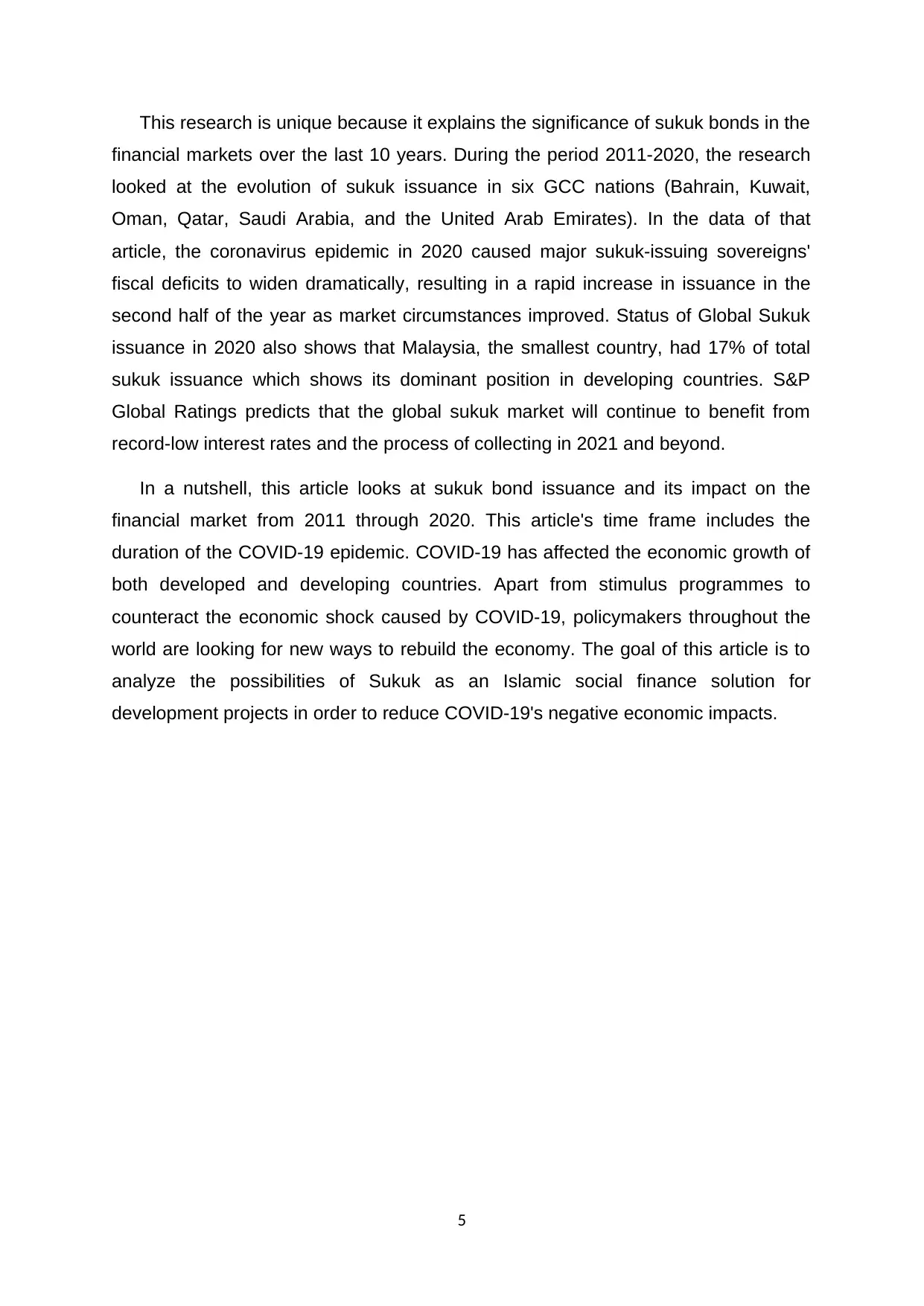
This research is unique because it explains the significance of sukuk bonds in the
financial markets over the last 10 years. During the period 2011-2020, the research
looked at the evolution of sukuk issuance in six GCC nations (Bahrain, Kuwait,
Oman, Qatar, Saudi Arabia, and the United Arab Emirates). In the data of that
article, the coronavirus epidemic in 2020 caused major sukuk-issuing sovereigns'
fiscal deficits to widen dramatically, resulting in a rapid increase in issuance in the
second half of the year as market circumstances improved. Status of Global Sukuk
issuance in 2020 also shows that Malaysia, the smallest country, had 17% of total
sukuk issuance which shows its dominant position in developing countries. S&P
Global Ratings predicts that the global sukuk market will continue to benefit from
record-low interest rates and the process of collecting in 2021 and beyond.
In a nutshell, this article looks at sukuk bond issuance and its impact on the
financial market from 2011 through 2020. This article's time frame includes the
duration of the COVID-19 epidemic. COVID-19 has affected the economic growth of
both developed and developing countries. Apart from stimulus programmes to
counteract the economic shock caused by COVID-19, policymakers throughout the
world are looking for new ways to rebuild the economy. The goal of this article is to
analyze the possibilities of Sukuk as an Islamic social finance solution for
development projects in order to reduce COVID-19's negative economic impacts.
5
financial markets over the last 10 years. During the period 2011-2020, the research
looked at the evolution of sukuk issuance in six GCC nations (Bahrain, Kuwait,
Oman, Qatar, Saudi Arabia, and the United Arab Emirates). In the data of that
article, the coronavirus epidemic in 2020 caused major sukuk-issuing sovereigns'
fiscal deficits to widen dramatically, resulting in a rapid increase in issuance in the
second half of the year as market circumstances improved. Status of Global Sukuk
issuance in 2020 also shows that Malaysia, the smallest country, had 17% of total
sukuk issuance which shows its dominant position in developing countries. S&P
Global Ratings predicts that the global sukuk market will continue to benefit from
record-low interest rates and the process of collecting in 2021 and beyond.
In a nutshell, this article looks at sukuk bond issuance and its impact on the
financial market from 2011 through 2020. This article's time frame includes the
duration of the COVID-19 epidemic. COVID-19 has affected the economic growth of
both developed and developing countries. Apart from stimulus programmes to
counteract the economic shock caused by COVID-19, policymakers throughout the
world are looking for new ways to rebuild the economy. The goal of this article is to
analyze the possibilities of Sukuk as an Islamic social finance solution for
development projects in order to reduce COVID-19's negative economic impacts.
5
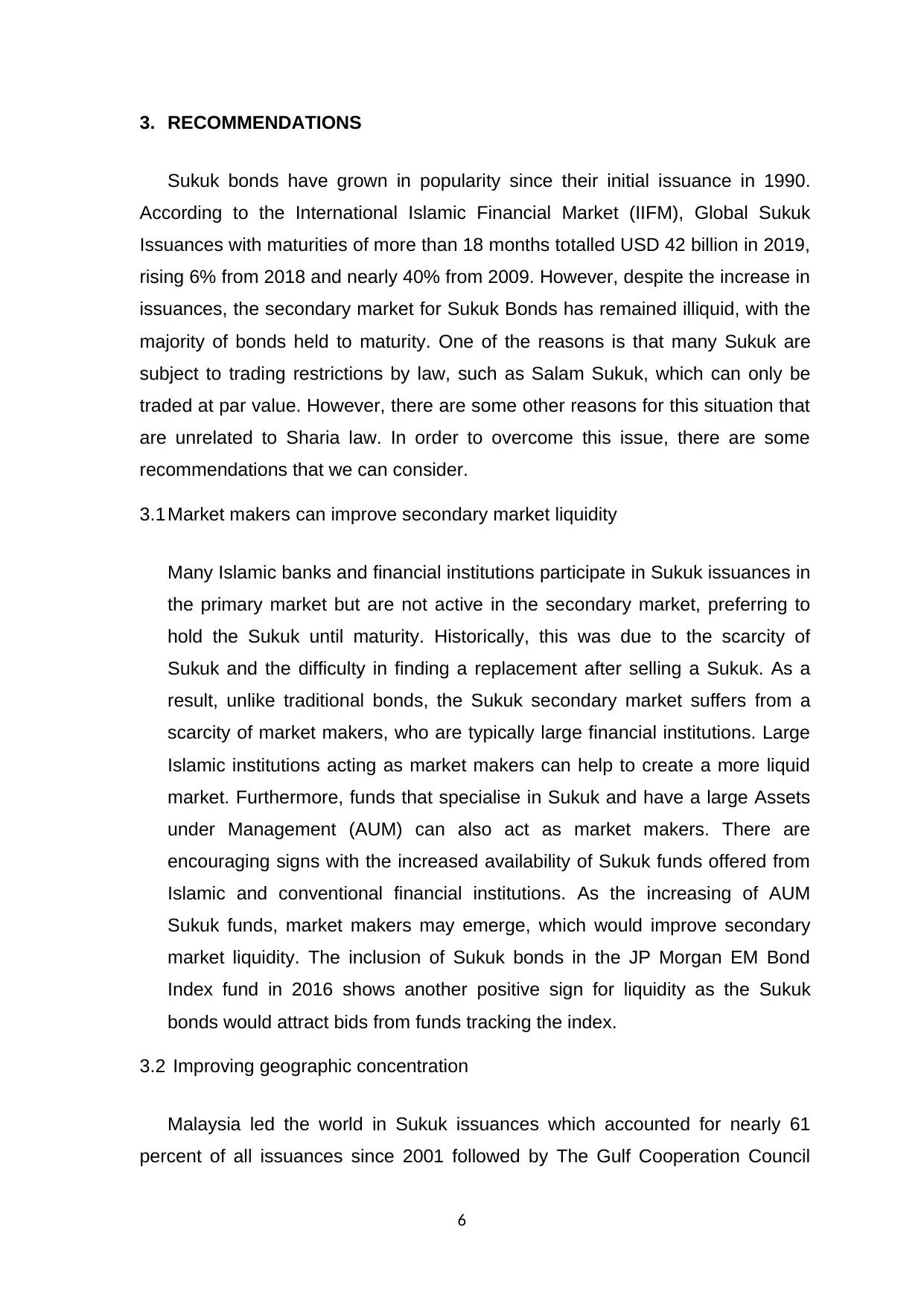
3. RECOMMENDATIONS
Sukuk bonds have grown in popularity since their initial issuance in 1990.
According to the International Islamic Financial Market (IIFM), Global Sukuk
Issuances with maturities of more than 18 months totalled USD 42 billion in 2019,
rising 6% from 2018 and nearly 40% from 2009. However, despite the increase in
issuances, the secondary market for Sukuk Bonds has remained illiquid, with the
majority of bonds held to maturity. One of the reasons is that many Sukuk are
subject to trading restrictions by law, such as Salam Sukuk, which can only be
traded at par value. However, there are some other reasons for this situation that
are unrelated to Sharia law. In order to overcome this issue, there are some
recommendations that we can consider.
3.1 Market makers can improve secondary market liquidity
Many Islamic banks and financial institutions participate in Sukuk issuances in
the primary market but are not active in the secondary market, preferring to
hold the Sukuk until maturity. Historically, this was due to the scarcity of
Sukuk and the difficulty in finding a replacement after selling a Sukuk. As a
result, unlike traditional bonds, the Sukuk secondary market suffers from a
scarcity of market makers, who are typically large financial institutions. Large
Islamic institutions acting as market makers can help to create a more liquid
market. Furthermore, funds that specialise in Sukuk and have a large Assets
under Management (AUM) can also act as market makers. There are
encouraging signs with the increased availability of Sukuk funds offered from
Islamic and conventional financial institutions. As the increasing of AUM
Sukuk funds, market makers may emerge, which would improve secondary
market liquidity. The inclusion of Sukuk bonds in the JP Morgan EM Bond
Index fund in 2016 shows another positive sign for liquidity as the Sukuk
bonds would attract bids from funds tracking the index.
3.2 Improving geographic concentration
Malaysia led the world in Sukuk issuances which accounted for nearly 61
percent of all issuances since 2001 followed by The Gulf Cooperation Council
6
Sukuk bonds have grown in popularity since their initial issuance in 1990.
According to the International Islamic Financial Market (IIFM), Global Sukuk
Issuances with maturities of more than 18 months totalled USD 42 billion in 2019,
rising 6% from 2018 and nearly 40% from 2009. However, despite the increase in
issuances, the secondary market for Sukuk Bonds has remained illiquid, with the
majority of bonds held to maturity. One of the reasons is that many Sukuk are
subject to trading restrictions by law, such as Salam Sukuk, which can only be
traded at par value. However, there are some other reasons for this situation that
are unrelated to Sharia law. In order to overcome this issue, there are some
recommendations that we can consider.
3.1 Market makers can improve secondary market liquidity
Many Islamic banks and financial institutions participate in Sukuk issuances in
the primary market but are not active in the secondary market, preferring to
hold the Sukuk until maturity. Historically, this was due to the scarcity of
Sukuk and the difficulty in finding a replacement after selling a Sukuk. As a
result, unlike traditional bonds, the Sukuk secondary market suffers from a
scarcity of market makers, who are typically large financial institutions. Large
Islamic institutions acting as market makers can help to create a more liquid
market. Furthermore, funds that specialise in Sukuk and have a large Assets
under Management (AUM) can also act as market makers. There are
encouraging signs with the increased availability of Sukuk funds offered from
Islamic and conventional financial institutions. As the increasing of AUM
Sukuk funds, market makers may emerge, which would improve secondary
market liquidity. The inclusion of Sukuk bonds in the JP Morgan EM Bond
Index fund in 2016 shows another positive sign for liquidity as the Sukuk
bonds would attract bids from funds tracking the index.
3.2 Improving geographic concentration
Malaysia led the world in Sukuk issuances which accounted for nearly 61
percent of all issuances since 2001 followed by The Gulf Cooperation Council
6
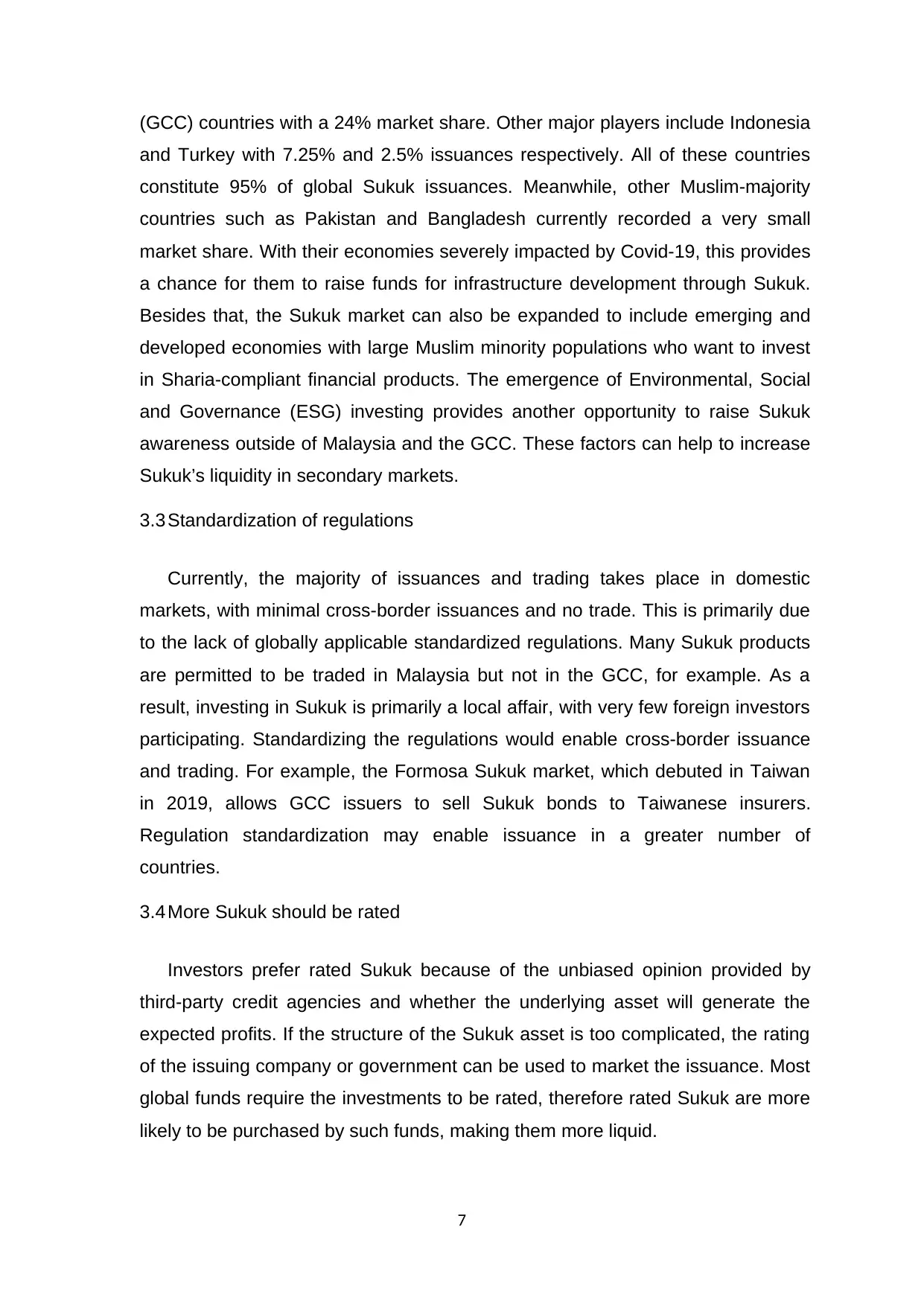
(GCC) countries with a 24% market share. Other major players include Indonesia
and Turkey with 7.25% and 2.5% issuances respectively. All of these countries
constitute 95% of global Sukuk issuances. Meanwhile, other Muslim-majority
countries such as Pakistan and Bangladesh currently recorded a very small
market share. With their economies severely impacted by Covid-19, this provides
a chance for them to raise funds for infrastructure development through Sukuk.
Besides that, the Sukuk market can also be expanded to include emerging and
developed economies with large Muslim minority populations who want to invest
in Sharia-compliant financial products. The emergence of Environmental, Social
and Governance (ESG) investing provides another opportunity to raise Sukuk
awareness outside of Malaysia and the GCC. These factors can help to increase
Sukuk’s liquidity in secondary markets.
3.3 Standardization of regulations
Currently, the majority of issuances and trading takes place in domestic
markets, with minimal cross-border issuances and no trade. This is primarily due
to the lack of globally applicable standardized regulations. Many Sukuk products
are permitted to be traded in Malaysia but not in the GCC, for example. As a
result, investing in Sukuk is primarily a local affair, with very few foreign investors
participating. Standardizing the regulations would enable cross-border issuance
and trading. For example, the Formosa Sukuk market, which debuted in Taiwan
in 2019, allows GCC issuers to sell Sukuk bonds to Taiwanese insurers.
Regulation standardization may enable issuance in a greater number of
countries.
3.4 More Sukuk should be rated
Investors prefer rated Sukuk because of the unbiased opinion provided by
third-party credit agencies and whether the underlying asset will generate the
expected profits. If the structure of the Sukuk asset is too complicated, the rating
of the issuing company or government can be used to market the issuance. Most
global funds require the investments to be rated, therefore rated Sukuk are more
likely to be purchased by such funds, making them more liquid.
7
and Turkey with 7.25% and 2.5% issuances respectively. All of these countries
constitute 95% of global Sukuk issuances. Meanwhile, other Muslim-majority
countries such as Pakistan and Bangladesh currently recorded a very small
market share. With their economies severely impacted by Covid-19, this provides
a chance for them to raise funds for infrastructure development through Sukuk.
Besides that, the Sukuk market can also be expanded to include emerging and
developed economies with large Muslim minority populations who want to invest
in Sharia-compliant financial products. The emergence of Environmental, Social
and Governance (ESG) investing provides another opportunity to raise Sukuk
awareness outside of Malaysia and the GCC. These factors can help to increase
Sukuk’s liquidity in secondary markets.
3.3 Standardization of regulations
Currently, the majority of issuances and trading takes place in domestic
markets, with minimal cross-border issuances and no trade. This is primarily due
to the lack of globally applicable standardized regulations. Many Sukuk products
are permitted to be traded in Malaysia but not in the GCC, for example. As a
result, investing in Sukuk is primarily a local affair, with very few foreign investors
participating. Standardizing the regulations would enable cross-border issuance
and trading. For example, the Formosa Sukuk market, which debuted in Taiwan
in 2019, allows GCC issuers to sell Sukuk bonds to Taiwanese insurers.
Regulation standardization may enable issuance in a greater number of
countries.
3.4 More Sukuk should be rated
Investors prefer rated Sukuk because of the unbiased opinion provided by
third-party credit agencies and whether the underlying asset will generate the
expected profits. If the structure of the Sukuk asset is too complicated, the rating
of the issuing company or government can be used to market the issuance. Most
global funds require the investments to be rated, therefore rated Sukuk are more
likely to be purchased by such funds, making them more liquid.
7
Paraphrase This Document
Need a fresh take? Get an instant paraphrase of this document with our AI Paraphraser
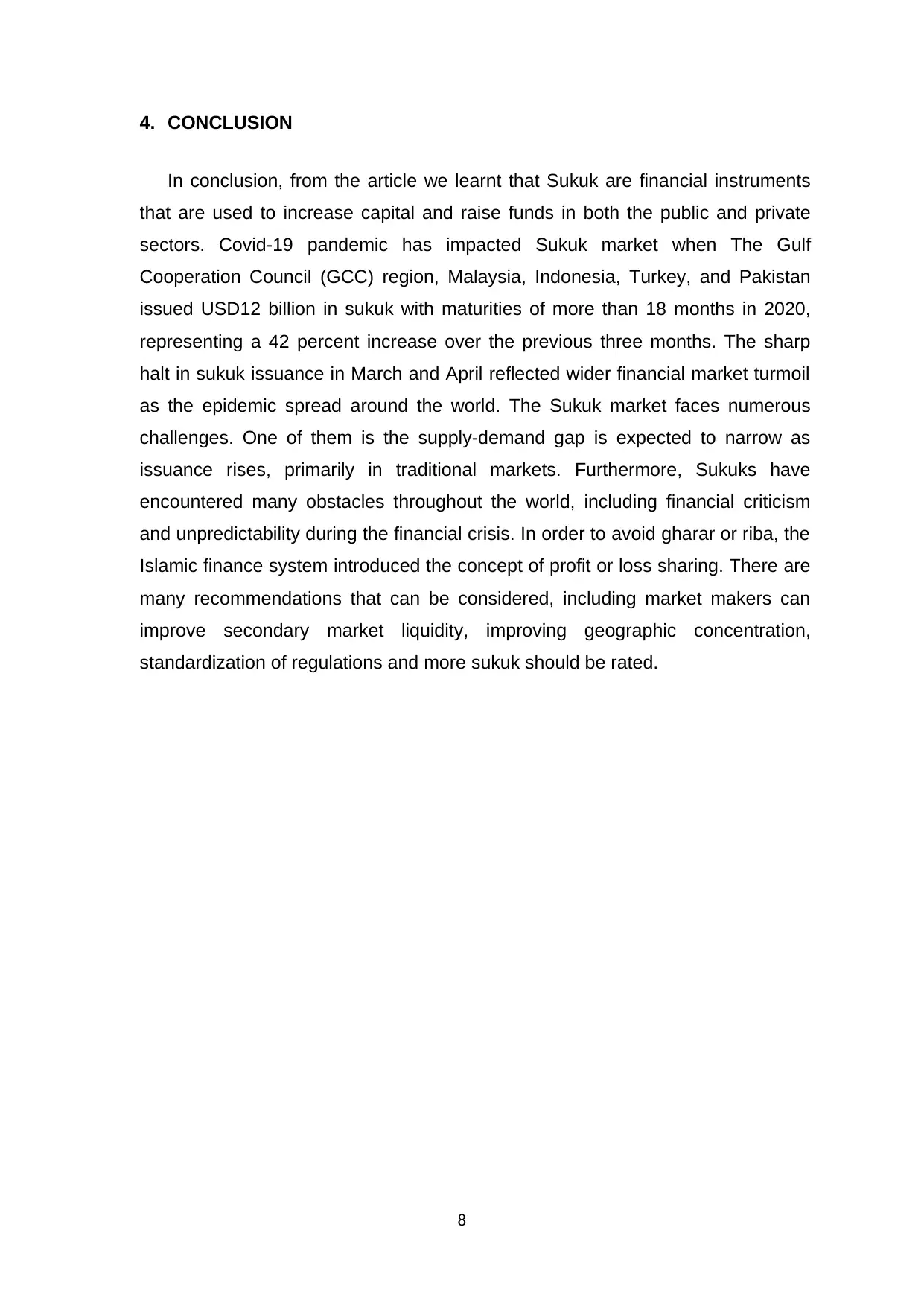
4. CONCLUSION
In conclusion, from the article we learnt that Sukuk are financial instruments
that are used to increase capital and raise funds in both the public and private
sectors. Covid-19 pandemic has impacted Sukuk market when The Gulf
Cooperation Council (GCC) region, Malaysia, Indonesia, Turkey, and Pakistan
issued USD12 billion in sukuk with maturities of more than 18 months in 2020,
representing a 42 percent increase over the previous three months. The sharp
halt in sukuk issuance in March and April reflected wider financial market turmoil
as the epidemic spread around the world. The Sukuk market faces numerous
challenges. One of them is the supply-demand gap is expected to narrow as
issuance rises, primarily in traditional markets. Furthermore, Sukuks have
encountered many obstacles throughout the world, including financial criticism
and unpredictability during the financial crisis. In order to avoid gharar or riba, the
Islamic finance system introduced the concept of profit or loss sharing. There are
many recommendations that can be considered, including market makers can
improve secondary market liquidity, improving geographic concentration,
standardization of regulations and more sukuk should be rated.
8
In conclusion, from the article we learnt that Sukuk are financial instruments
that are used to increase capital and raise funds in both the public and private
sectors. Covid-19 pandemic has impacted Sukuk market when The Gulf
Cooperation Council (GCC) region, Malaysia, Indonesia, Turkey, and Pakistan
issued USD12 billion in sukuk with maturities of more than 18 months in 2020,
representing a 42 percent increase over the previous three months. The sharp
halt in sukuk issuance in March and April reflected wider financial market turmoil
as the epidemic spread around the world. The Sukuk market faces numerous
challenges. One of them is the supply-demand gap is expected to narrow as
issuance rises, primarily in traditional markets. Furthermore, Sukuks have
encountered many obstacles throughout the world, including financial criticism
and unpredictability during the financial crisis. In order to avoid gharar or riba, the
Islamic finance system introduced the concept of profit or loss sharing. There are
many recommendations that can be considered, including market makers can
improve secondary market liquidity, improving geographic concentration,
standardization of regulations and more sukuk should be rated.
8
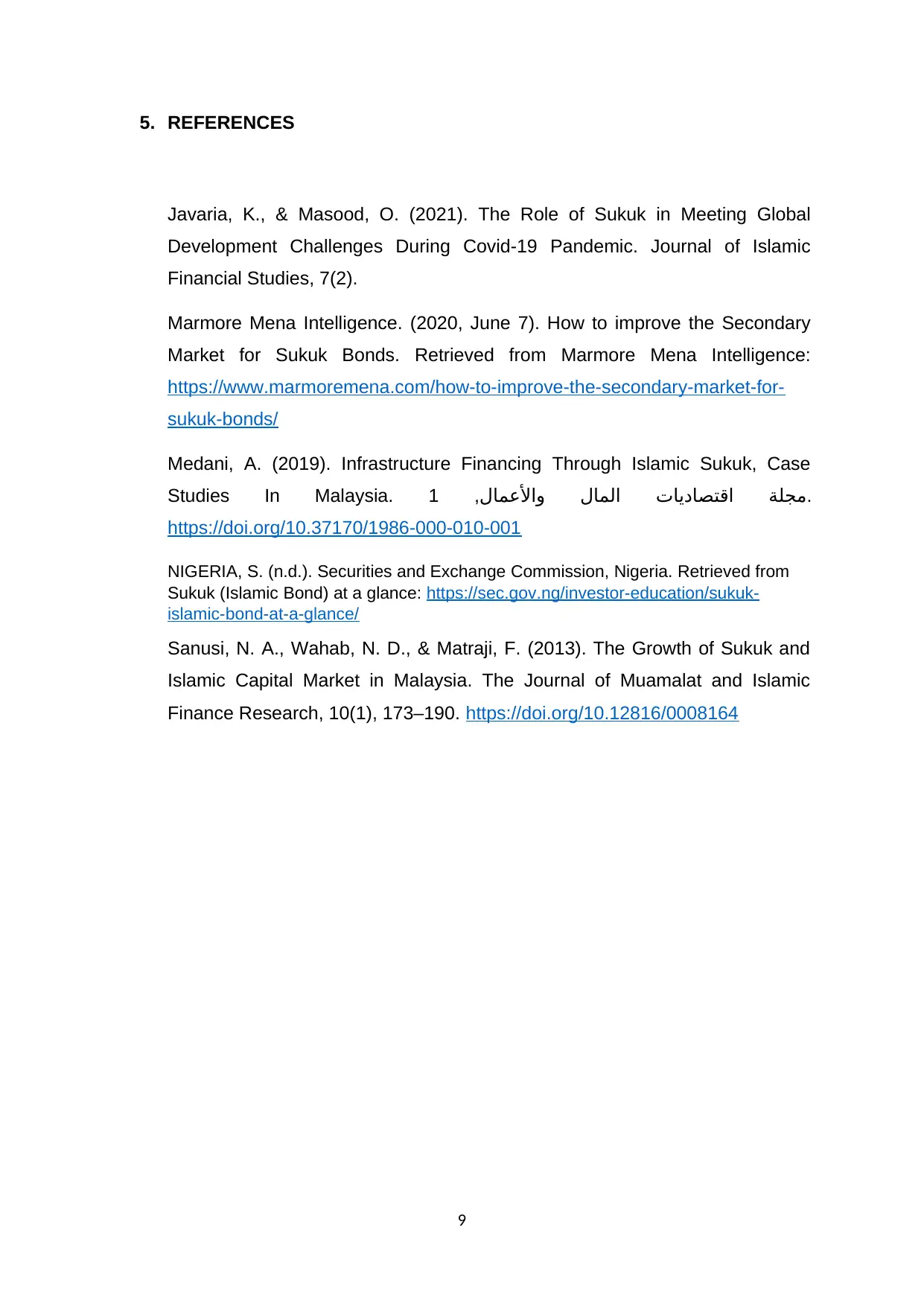
5. REFERENCES
Javaria, K., & Masood, O. (2021). The Role of Sukuk in Meeting Global
Development Challenges During Covid-19 Pandemic. Journal of Islamic
Financial Studies, 7(2).
Marmore Mena Intelligence. (2020, June 7). How to improve the Secondary
Market for Sukuk Bonds. Retrieved from Marmore Mena Intelligence:
https://www.marmoremena.com/how-to-improve-the-secondary-market-for-
sukuk-bonds/
Medani, A. (2019). Infrastructure Financing Through Islamic Sukuk, Case
Studies In Malaysia. ,واألعمال المال اقتصاديات مجلة1 .
https://doi.org/10.37170/1986-000-010-001
NIGERIA, S. (n.d.). Securities and Exchange Commission, Nigeria. Retrieved from
Sukuk (Islamic Bond) at a glance: https://sec.gov.ng/investor-education/sukuk-
islamic-bond-at-a-glance/
Sanusi, N. A., Wahab, N. D., & Matraji, F. (2013). The Growth of Sukuk and
Islamic Capital Market in Malaysia. The Journal of Muamalat and Islamic
Finance Research, 10(1), 173–190. https://doi.org/10.12816/0008164
9
Javaria, K., & Masood, O. (2021). The Role of Sukuk in Meeting Global
Development Challenges During Covid-19 Pandemic. Journal of Islamic
Financial Studies, 7(2).
Marmore Mena Intelligence. (2020, June 7). How to improve the Secondary
Market for Sukuk Bonds. Retrieved from Marmore Mena Intelligence:
https://www.marmoremena.com/how-to-improve-the-secondary-market-for-
sukuk-bonds/
Medani, A. (2019). Infrastructure Financing Through Islamic Sukuk, Case
Studies In Malaysia. ,واألعمال المال اقتصاديات مجلة1 .
https://doi.org/10.37170/1986-000-010-001
NIGERIA, S. (n.d.). Securities and Exchange Commission, Nigeria. Retrieved from
Sukuk (Islamic Bond) at a glance: https://sec.gov.ng/investor-education/sukuk-
islamic-bond-at-a-glance/
Sanusi, N. A., Wahab, N. D., & Matraji, F. (2013). The Growth of Sukuk and
Islamic Capital Market in Malaysia. The Journal of Muamalat and Islamic
Finance Research, 10(1), 173–190. https://doi.org/10.12816/0008164
9
1 out of 9
Related Documents
Your All-in-One AI-Powered Toolkit for Academic Success.
+13062052269
info@desklib.com
Available 24*7 on WhatsApp / Email
![[object Object]](/_next/static/media/star-bottom.7253800d.svg)
Unlock your academic potential
© 2024 | Zucol Services PVT LTD | All rights reserved.
